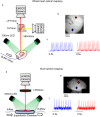High resolution optical mapping of cardiac electrophysiology in pre-clinical models
- PMID: 35361792
- PMCID: PMC8971487
- DOI: 10.1038/s41597-022-01253-1
High resolution optical mapping of cardiac electrophysiology in pre-clinical models
Erratum in
-
Publisher Correction: High resolution optical mapping of cardiac electrophysiology in pre-clinical models.Sci Data. 2024 Jan 18;11(1):93. doi: 10.1038/s41597-024-02941-w. Sci Data. 2024. PMID: 38238379 Free PMC article. No abstract available.
Abstract
Optical mapping of animal models is a widely used technique in pre-clinical cardiac research. It has several advantages over other methods, including higher spatial resolution, contactless recording and direct visualisation of action potentials and calcium transients. Optical mapping enables simultaneous study of action potential and calcium transient morphology, conduction dynamics, regional heterogeneity, restitution and arrhythmogenesis. In this dataset, we have optically mapped Langendorff perfused isolated whole hearts (mouse and guinea pig) and superfused isolated atria (mouse). Raw datasets (consisting of over 400 files) can be combined with open-source software for processing and analysis. We have generated a comprehensive post-processed dataset characterising the baseline cardiac electrophysiology in these widely used pre-clinical models. This dataset also provides reference information detailing the effect of heart rate, clinically used anti-arrhythmic drugs, ischaemia-reperfusion and sympathetic nervous stimulation on cardiac electrophysiology. The effects of these interventions can be studied in a global or regional manner, enabling new insights into the prevention and initiation of arrhythmia.
© 2022. The Author(s).
Conflict of interest statement
The authors declare no competing interests.
Figures







Similar articles
-
The effect of sex and age on ex vivo cardiac electrophysiology: insight from a guinea pig model.Am J Physiol Heart Circ Physiol. 2023 Jan 1;324(1):H141-H154. doi: 10.1152/ajpheart.00497.2022. Epub 2022 Dec 9. Am J Physiol Heart Circ Physiol. 2023. PMID: 36487188 Free PMC article.
-
The kinetics of spontaneous calcium oscillations and arrhythmogenesis in the in vivo heart during ischemia/reperfusion.Heart Rhythm. 2006 Jan;3(1):58-66. doi: 10.1016/j.hrthm.2005.09.018. Heart Rhythm. 2006. PMID: 16399055
-
In vivo ratiometric optical mapping enables high-resolution cardiac electrophysiology in pig models.Cardiovasc Res. 2019 Sep 1;115(11):1659-1671. doi: 10.1093/cvr/cvz039. Cardiovasc Res. 2019. PMID: 30753358 Free PMC article.
-
Optical Mapping.Card Electrophysiol Clin. 2019 Sep;11(3):495-510. doi: 10.1016/j.ccep.2019.04.004. Card Electrophysiol Clin. 2019. PMID: 31400874 Review.
-
Optical mapping and optogenetics in cardiac electrophysiology research and therapy: a state-of-the-art review.Europace. 2024 Feb 1;26(2):euae017. doi: 10.1093/europace/euae017. Europace. 2024. PMID: 38227822 Free PMC article. Review.
Cited by
-
The effect of sex and age on ex vivo cardiac electrophysiology: insight from a guinea pig model.Am J Physiol Heart Circ Physiol. 2023 Jan 1;324(1):H141-H154. doi: 10.1152/ajpheart.00497.2022. Epub 2022 Dec 9. Am J Physiol Heart Circ Physiol. 2023. PMID: 36487188 Free PMC article.
-
Mechanistic Relevance of Ventricular Arrhythmias in Heart Failure with Preserved Ejection Fraction.Int J Mol Sci. 2024 Dec 14;25(24):13423. doi: 10.3390/ijms252413423. Int J Mol Sci. 2024. PMID: 39769189 Free PMC article. Review.
-
A Comprehensive Review of a Mechanism-Based Ventricular Electrical Storm Management.J Clin Med. 2025 Jul 29;14(15):5351. doi: 10.3390/jcm14155351. J Clin Med. 2025. PMID: 40806975 Free PMC article. Review.
-
Electroanatomical adaptations in the guinea pig heart from neonatal to adulthood.Europace. 2024 Jul 2;26(7):euae158. doi: 10.1093/europace/euae158. Europace. 2024. PMID: 38864516 Free PMC article.
-
Optogenetic stimulation and simultaneous optical mapping of membrane potential and calcium transients in human engineered cardiac spheroids.J Mol Cell Cardiol. 2025 Feb;199:51-59. doi: 10.1016/j.yjmcc.2024.12.003. Epub 2024 Dec 16. J Mol Cell Cardiol. 2025. PMID: 39674364
References
Publication types
MeSH terms
Substances
Grants and funding
LinkOut - more resources
Full Text Sources

